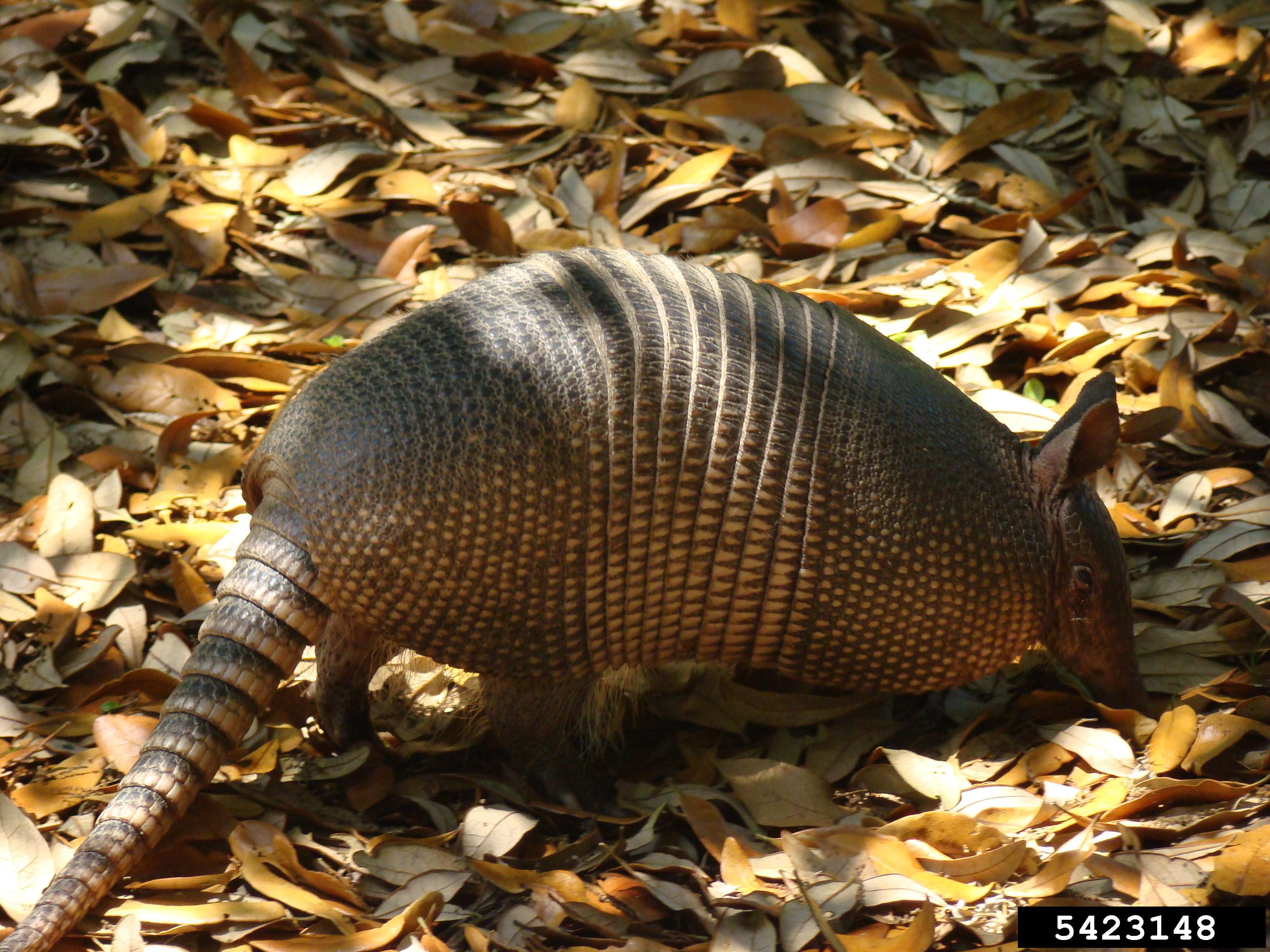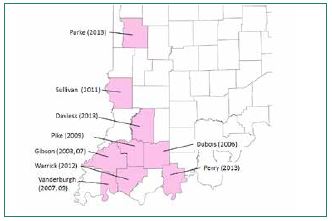Armadillos in Indiana?
By Brian J. MacGowan
Armadillos are limited to South, Central and North America. The nine-banded armadillo (Dasypus novemcintus), the species we have in the U.S., gets its name from the nine moveable rings of armor between its shoulder and its hip shield. Its moveable armor shell defends them against predators and their sometimes rough life below ground (Figure 1).  Figure 1. The nine-banded armadillo (Dasypus novemcintus) gets its name from the nine moveable rings of armor between its shoulder and its hip shield. (Image credit: Rebekah D. Wallace, University of Georgia, Bugwood.org)Full grown adults are about the size of an opossum; males are slightly larger than females. Armadillos spend a lot of time on the ground and in burrows. They will root about on the ground looking for grubs and insects.
Figure 1. The nine-banded armadillo (Dasypus novemcintus) gets its name from the nine moveable rings of armor between its shoulder and its hip shield. (Image credit: Rebekah D. Wallace, University of Georgia, Bugwood.org)Full grown adults are about the size of an opossum; males are slightly larger than females. Armadillos spend a lot of time on the ground and in burrows. They will root about on the ground looking for grubs and insects.
There have been 11 confirmed Armadillo sightings in Indiana since 2003 (Figure 2). As of now, armadillos are considered an exotic species in Indiana (312 IAC 9-3-18.5). They cannot be possessed without a permit, but according to law, a landowner or tenant can “take” an exotic animal when it is destroying or causing substantial damage to property.
Why has this happened?
The geographic distribution of wildlife species is never static. Populations along the
In addition, animals, typically young males, can disperse long distances beyond their established range. These are not considered range expansions and are not generally reflected on distribution maps. For example, you may have recalled a wolf was shot and killed in Indiana in 2003. This was not an animal from a free-ranging breeding population in Indiana, but simply a young male that dispersed a very long distance from Wisconsin. Given the recent expansion of armadillos in our neighboring states and the number of sightings in recent years (three in 2013), it is likely that armadillos are here to stay. It’s unclear how this past winter’s cold temperature and snow will affect populations. When the ground is frozen, armadillos can’t dig to find food. While they can escape cold temperatures by retreating to their burrow, they cannot hibernate and may likely freeze or starve.
Most people are familiar with geographic distribution maps of species. While these maps are helpful in quickly allowing you to decipher the general whereabouts of a species, they do have their limitations. Their accuracy is dependent upon the information we have about the distribution of various species. Unfortunately, this information is lacking since many species of wildlife are difficult to observe and monitor. The result is maps which summarize our “best guess” of animal distributions. The map provided here only shows the counties it has been observed and reported to date. A more complete and accurate picture is desirable.
Dr. John Whitaker at Indiana State University has been compiling data on armadillo sightings in Indiana. Indiana residents can report sightings directly to him by email. To report a sighting, please send photos, date of sighting, specific localities (for example, county, township, address, nearest road intersection), and details (for example, live/dead, behavior) to John.Whitaker@indstate.edu.
Should you be concerned?
It’s difficult to say. Armadillos can dig holes and uproot plants in lawns, flower beds and gardens from their rooting behavior while searching for food. The burrow systems they construct for cover and to raise young could also be undesirable in yards, fields or under foundations and other structures. Clearly these habits can be a nuisance and cause damage. It remains to be seen whether or not armadillos can thrive in Indiana or the impact that will have on other wildlife species.
Acknowledgements: Information on Indiana sightings were graciously provided by Dr. John Whitaker, Indiana State University.
Brian MacGowan is an Extension Wildlife Specialist with Purdue University’s Department of Forestry. He also has served as secretary and editor for the Woodland Steward since 2008.
